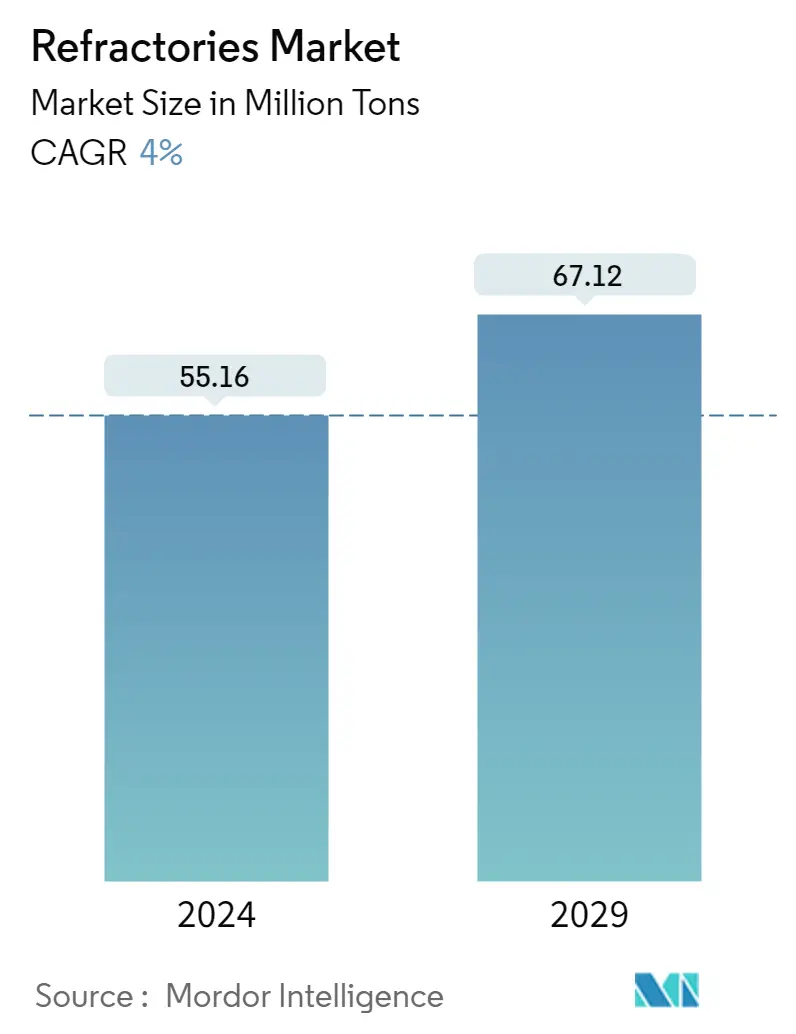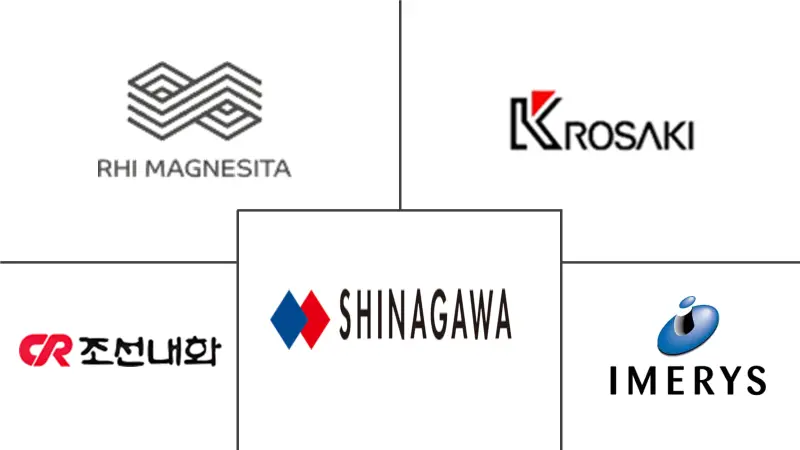Market Size of Refractories Industry

| Study Period | 2019 - 2029 |
| Base Year For Estimation | 2023 |
| CAGR (2024 - 2029) | 4.00 % |
| Fastest Growing Market | Asia Pacific |
| Largest Market | Asia Pacific |
| Market Concentration | Low |
Major Players
*Disclaimer: Major Players sorted in no particular order |
Refractories Market Analysis
The Refractories Market size is estimated at 55.16 Million tons in 2024, and is expected to reach 67.12 Million tons by 2029, growing at a CAGR of 4% during the forecast period (2024-2029).
Due to COVID-19, numerous countries were in lockdown, significantly affecting the global economy, and economic and industrial activities were temporarily halted. The refractories market also witnessed a repercussion in production and demand from the end-user industries, such as iron and steel, cement, energy and chemicals, ceramics, etc. Although in the post-pandemic period, the end-user industries are growing because of the growing demand for products after economies open up.
- Over the medium term, the significant factors driving the market studied are the strong growth of iron and steel production in emerging countries and the increased output of non-ferrous materials. The refractories are used for internal lining applications in iron steel and non-ferrous productions.
- Moreover, high demand from the glass industry is the primary factor driving the growth.
- On the flip side, due to increasing environmental awareness, government agencies and environmental agencies worldwide are laying down guidelines regarding the usage and disposal of refractories. It is likely to hinder market growth.
- The growth potential of the Indian steel industry is expected to provide new opportunities for the market studied.
- The Asia-Pacific region will likely dominate the market and register the highest CAGR. Emerging countries like China, Russia, Mexico, and South Africa are investing heavily in large-scale infrastructure projects, which are expected to boost the iron and steel industry's growth significantly.
Refractories Industry Segmentation
A refractory material is a material that, at high temperatures, is resistant to decomposition by heat, pressure, or chemical attack and retains strength and form. For their safe, low-maintenance, and cost-effective operations, refractories are used as a primary material for internal linings in large industrial equipment. The refractories market is segmented by product type, end-user industry, and geography (Asia-Pacific, North America, Europe, South America, and Africa). By product type, the market is segmented into non-clay refractories and clay refractories. By end-user industry, the market is segmented into iron and steel, energy and chemicals, non-ferrous metals, cement, ceramics, glass, and others. The report also covers the market size and forecasts for the refractories market in 15 countries across the central regions. For each segment, market sizing and forecasts have been done based on volume (kilo tons).
| Product Type | |||||||
| |||||||
|
| End-user Industry | |
| Iron and Steel | |
| Energy and Chemicals | |
| Non-ferrous Metals | |
| Cement | |
| Ceramic | |
| Glass | |
| Other End-user Industries |
| Geography | |||||||
| |||||||
| |||||||
| |||||||
| |||||||
|
Refractories Market Size Summary
The refractories market is poised for growth, driven by the robust expansion of the iron and steel industry, particularly in emerging economies. Refractories, essential for high-temperature applications, are predominantly used in the iron and steel sector, which constitutes a significant portion of the market. The post-pandemic recovery has seen a resurgence in demand from various end-user industries, including cement, energy, and chemicals. The Asia-Pacific region, led by China and India, is expected to dominate the market due to substantial investments in infrastructure and industrial projects. However, environmental regulations and guidelines on the use and disposal of refractories pose challenges to market growth.
The market landscape is characterized by fragmentation, with key players like RHI Magnesita GmbH, Chosun Refractories ENG Co., Ltd., and others actively expanding their capacities and portfolios through strategic acquisitions. These companies are capitalizing on the growing demand for refractories, particularly in the Asia-Pacific region, where China leads in steel production. The Indian steel industry's growth potential also presents new opportunities for market expansion. Despite political and economic uncertainties in regions like the European Union, the overall demand for refractories is expected to rise, supported by ongoing developments in the global steel production landscape.
Refractories Market Size - Table of Contents
-
1. MARKET DYNAMICS
-
1.1 Drivers
-
1.1.1 Continuous Usage of Refractories in the Iron and Steel Industry
-
1.1.2 Increase in the Production of Non-ferrous Metals
-
-
1.2 Restraints
-
1.2.1 Decreasing Production of Refractories in China
-
1.2.2 Other Restraints
-
-
1.3 Industry Value Chain Analysis
-
1.4 Porter's Five Forces Analysis
-
1.4.1 Bargaining Power of Suppliers
-
1.4.2 Bargaining Power of Consumers
-
1.4.3 Threat of New Entrants
-
1.4.4 Threat of Substitute Products and Services
-
1.4.5 Degree of Competition
-
-
-
2. MARKET SEGMENTATION (Market Size in Volume)
-
2.1 Product Type
-
2.1.1 Non-clay Refractory
-
2.1.1.1 Magnesite Brick (Dead Burned Magnesia, Fused Magnesia, and Caustic Calcined Magnesia)
-
2.1.1.2 Zirconia Brick
-
2.1.1.3 Silica Brick
-
2.1.1.4 Chromite Brick
-
2.1.1.5 Other Product Types (Carbides, Silicates)
-
-
2.1.2 Clay Refractory
-
2.1.2.1 High Alumina
-
2.1.2.2 Fireclay
-
2.1.2.3 Insulating
-
-
-
2.2 End-user Industry
-
2.2.1 Iron and Steel
-
2.2.2 Energy and Chemicals
-
2.2.3 Non-ferrous Metals
-
2.2.4 Cement
-
2.2.5 Ceramic
-
2.2.6 Glass
-
2.2.7 Other End-user Industries
-
-
2.3 Geography
-
2.3.1 Asia-Pacific
-
2.3.1.1 China
-
2.3.1.2 India
-
2.3.1.3 Japan
-
2.3.1.4 South Korea
-
2.3.1.5 Rest of Asia-Pacific
-
-
2.3.2 North America
-
2.3.2.1 United States
-
2.3.2.2 Canada
-
2.3.2.3 Mexico
-
-
2.3.3 Europe
-
2.3.3.1 Germany
-
2.3.3.2 United Kingdom
-
2.3.3.3 Italy
-
2.3.3.4 France
-
2.3.3.5 Rest of Europe
-
-
2.3.4 South America
-
2.3.4.1 Brazil
-
2.3.4.2 Argentina
-
2.3.4.3 Rest of South America
-
-
2.3.5 Middle-East and Africa
-
2.3.5.1 Saudi Arabia
-
2.3.5.2 South Africa
-
2.3.5.3 Rest of Middle-East and Africa
-
-
-
Refractories Market Size FAQs
How big is the Refractories Market?
The Refractories Market size is expected to reach 55.16 million tons in 2024 and grow at a CAGR of 4% to reach 67.12 million tons by 2029.
What is the current Refractories Market size?
In 2024, the Refractories Market size is expected to reach 55.16 million tons.

